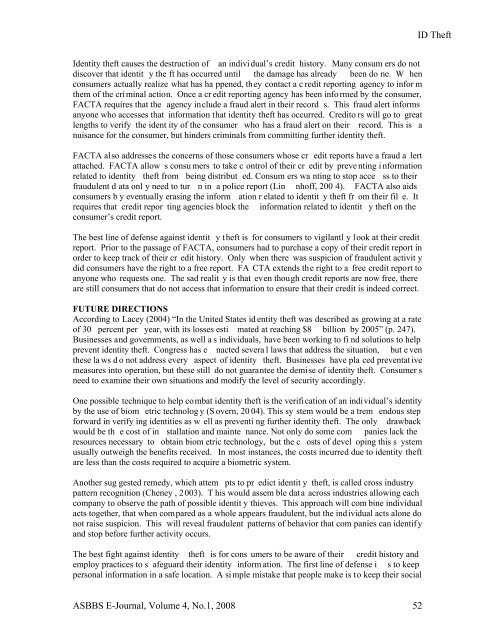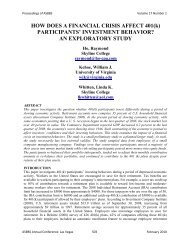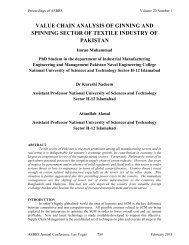stock repurchase announcements: a test of market ... - Asbbs.org
stock repurchase announcements: a test of market ... - Asbbs.org
stock repurchase announcements: a test of market ... - Asbbs.org
You also want an ePaper? Increase the reach of your titles
YUMPU automatically turns print PDFs into web optimized ePapers that Google loves.
Identity theft causes the destruction <strong>of</strong> an indivi dual’s credit history. Many consum ers do not<br />
discover that identit y the ft has occurred until the damage has already been do ne. W hen<br />
consumers actually realize what has ha ppened, they contact a c redit reporting agency to infor m<br />
them <strong>of</strong> the criminal action. Once a cr edit reporting agency has been info rmed by the consumer,<br />
FACTA requires that the agency include a fraud alert in their record s. This fraud alert informs<br />
anyone who accesses that information that identity theft has occurred. Credito rs will go to great<br />
lengths to verify the ident ity <strong>of</strong> the consumer who has a fraud alert on their record. This is a<br />
nuisance for the consumer, but hinders criminals from committing further identity theft.<br />
FACTA also addresses the concerns <strong>of</strong> those consumers whose cr edit reports have a fraud a lert<br />
attached. FACTA allow s consu mers to take c ontrol <strong>of</strong> their cr edit by preve nting i nformation<br />
related to identity theft from being distribut ed. Consum ers wa nting to stop acce ss to their<br />
fraudulent d ata onl y need to tur n in a police report (Lin nh<strong>of</strong>f, 200 4). FACTA also aids<br />
consumers b y eventually erasing the inform ation r elated to identit y theft fr om their fil e. It<br />
requires that credit repor ting agencies block the information related to identit y theft on the<br />
consumer’s credit report.<br />
The best line <strong>of</strong> defense against identit y theft is for consumers to vigilantl y look at their credit<br />
report. Prior to the passage <strong>of</strong> FACTA, consumers had to purchase a copy <strong>of</strong> their credit report in<br />
order to keep track <strong>of</strong> their cr edit history. Only when there was suspicion <strong>of</strong> fraudulent activit y<br />
did consumers have the right to a free report. FA CTA extends the right to a free credit report to<br />
anyone who requests one. The sad realit y is that even though credit reports are now free, there<br />
are still consumers that do not access that information to ensure that their credit is indeed correct.<br />
FUTURE DIRECTIONS<br />
According to Lacey (2004) “In the United States id entity theft was described as growing at a rate<br />
<strong>of</strong> 30 percent per year, with its losses esti mated at reaching $8 billion by 2005” (p. 247).<br />
Businesses and governments, as well a s individuals, have been working to fi nd solutions to help<br />
prevent identity theft. Congress has e nacted severa l laws that address the situation, but e ven<br />
these la ws d o not address every aspect <strong>of</strong> identity theft. Businesses have pla ced preventat ive<br />
measures into operation, but these still do not guarantee the demise <strong>of</strong> identity theft. Consumer s<br />
need to examine their own situations and modify the level <strong>of</strong> security accordingly.<br />
One possible technique to help combat identity theft is the verification <strong>of</strong> an individual’s identity<br />
by the use <strong>of</strong> biom etric technolog y (S overn, 20 04). This sy stem would be a trem endous step<br />
forward in verify ing identities as w ell as preventi ng further identity theft. The only drawback<br />
would be th e cost <strong>of</strong> in stallation and mainte nance. Not only do some com panies lack the<br />
resources necessary to obtain biom etric technology, but the c osts <strong>of</strong> devel oping this s ystem<br />
usually outweigh the benefits received. In most instances, the costs incurred due to identity theft<br />
are less than the costs required to acquire a biometric system.<br />
Another sug gested remedy, which attem pts to pr edict identit y theft, is called cross industry<br />
pattern recognition (Cheney , 2003). T his would assem ble data across industries allowing each<br />
company to observe the path <strong>of</strong> possible identit y thieves. This approach will com bine individual<br />
acts together, that when compared as a whole appears fraudulent, but the individual acts alone do<br />
not raise suspicion. This will reveal fraudulent patterns <strong>of</strong> behavior that com panies can identif y<br />
and stop before further activity occurs.<br />
The best fight against identity theft is for cons umers to be aware <strong>of</strong> their credit history and<br />
employ practices to s afeguard their identity inform ation. The first line <strong>of</strong> defense i s to keep<br />
personal information in a safe location. A si mple mistake that people make is to keep their social<br />
ASBBS E-Journal, Volume 4, No.1, 2008 52<br />
ID Theft

















